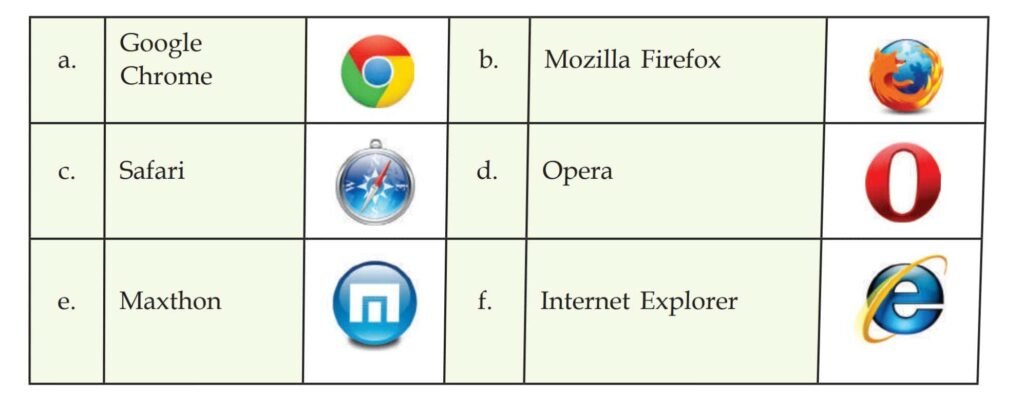What is a Web Browser ?
Web Browser :-
- A browser is a software that lets you view web pages, graphics and the online content. Browser software is specifically designed to convert HTML and XML into readable documents.
- The most popular web browsers are: Google Chrome, Firefox, Internet Explorer, Safari, Opera and UC Browser.
Web Browser Tool Bar :-
The Tool Bar is much like the Menu Bar stretching from left to right across the top of your screen just under the Address Bar –
- Back button : Helps to open the previously opened website.
- Back history : Helps to bring up a list of the sites visited.
- Forward button : This button will only be available once you have used the Back button at least once. It helps to take you to the page you just left when you clicked on the Back button.
- Forward history : That brings up a list of the sites you have visited and then used the Back button to return.
- Stop : Helps to stop the current download.
- Refresh : Gives the most recent version of the page that we are on.
- Home : Helps you to instantly get back home page (first page).
- Search : Helps to retrieve the specified files using web search engine.
- Favourites : Helps to open up the most frequently visited sites.
- History : Helps you to see where you have been on the Internet.
SSL :-
- The Secure Sockets Layer (SSL) is a protocol, uses Hypertext Transfer Protocol (HTTP) and Transport Control Protocol (TCP) for managing the security of a message transmission on the Internet. The “sockets” term refers to the sockets method of passing data back and forth between a client and a server program in a network or between program layers in the same computer. SSL uses the public-and-private key encryption system, which also includes the use of a digital certificate.
Various Web browsers available in the market:-


Latest Computer Post :- Click Here
Important Point :-
❖ The World Wide Web (WWW) is an internet based service, which uses common set of rules known as Protocols, to distribute documents across the Internet in a standard way.
❖ The Internet is a massive network of networks. It connects millions of computers together globally, forming a network in which any computer can communicate with any other computer as long as they are both connected to the Internet.
❖ Search engines are the programs which are needed to extract the information from the internet.
❖ A search engine works in the following order: Web crawling, Indexing, Searching
❖ A web server commonly known as HTTP server or application server is a program that serves content using the HTTP protocol.
❖ A Web page can contain an article, or a single paragraph, photographs, and it is usually a combination of text and graphics.
❖ A browser is a software that lets you view web pages, graphics and the online content.
❖ The Secure Sockets Layer (SSL) is a protocol, uses Hypertext Transfer Protocol (HTTP) and Transport Control Protocol (TCP) for managing the security of a message transmission on the Internet.
❖ A blog is a web site like any other, but it is intended to offer personal opinions of people on their hobbies, interests, commentaries, photo blogs, etc.
❖ URL’s, or ‘uniform resource locators’, are the web browser addresses of internet pages and files. It is the way to locate a file or document on the Internet.
There are two types of URL: Absolute and Relative.
A protocol is a set of rules that governs the communication between computers on a network.
Basic internet Computer Questions and Answers
Q: What is the internet?
(a) a single network
(b) a vast collection of different networks
(c) interconnection of local area networks
(d) none of the mentioned
Click to show/hide
Q: What is an ‘intranet’?
(a) Internal internet is used to transfer information internally
(b) Internal internet is used to transfer information to the outside company.
(c) Internal network designed to serve the internal formational needs of a single organization.
(d) Internal network designed to transfer information between two organizations
Click to show/hide
Q: __ servers store and manage files for network users.
(a) Authentication
(b) Main
(c) Web
(d) File
Click to show/hide
Q: ISP stands for
(a) Internet Security Protocol
(b) Intelligent Service Package
(c) Internet Service Provider
(d) Intelligent Service Provider
Click to show/hide
Q: Which one of the following protocols is not used on the internet?
(a) HTTP
(b) DHCP
(c) DNS
(d) none of the mentioned
Click to show/hide
Q: What does the internet term “thread” refer to?
(a) A series of linked messages
(b) A self-replicating virus
(c) A category of browser
(d) A common fault in display devices
Click to show/hide
Q: What’s the name of the program or service that lets you view e-mail messages ?
(a) Web browser
(b) E-mail clients
(c) E-mail id
(d) Internet
Click to show/hide
Q: When sending an e-mail, the ______ line describes the contents of the message?
(a) to
(b) subject
(c) contents
(d) CC
Click to show/hide
Q: http stands for
(a) hyper text transfer protocol
(b) hypertet transmission protocol
(c) high transfer transport protocol
(d) hyper transfer text protocol
Click to show/hide
Q: Internet access by transmitting digital data over the wires of a local telephone network is provided by
(a) leased line
(b) digital subscriber line
(c) digital signal line
(d) none of the mentioned
Click to show/hide
Q: Sending an e-mail is similar to __
(a) picturing an event
(b) narrating a story
(c) writing a letter
(d) creating a drawing
Click to show/hide
Q: What does SMTP in an SMTP server stand for ?
(a) Simple Mail Transfer Protocol
(b) Serve Message Text Process
(c) Short Messaging Text Process
(d) Short Messaging Transfer Protocol
Answer ⇒ ??
